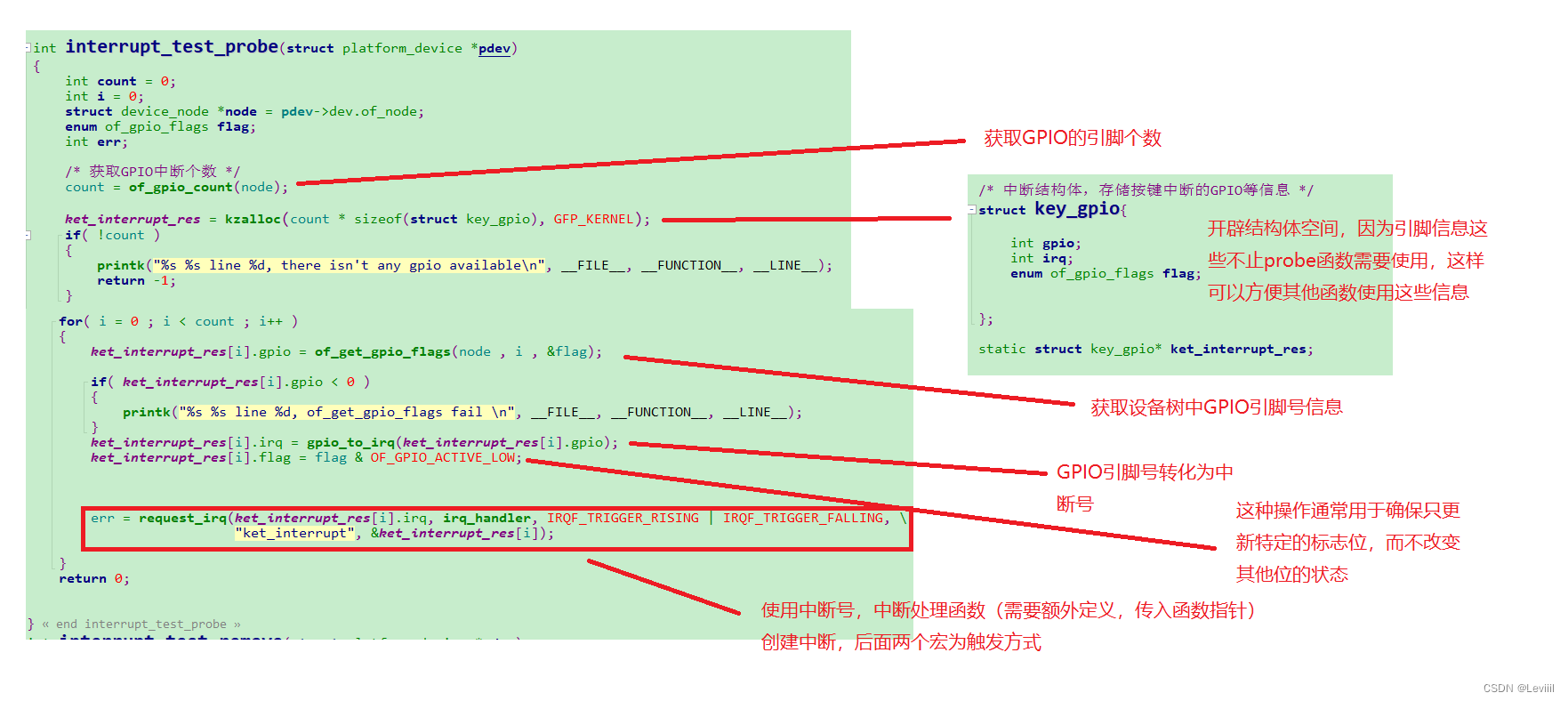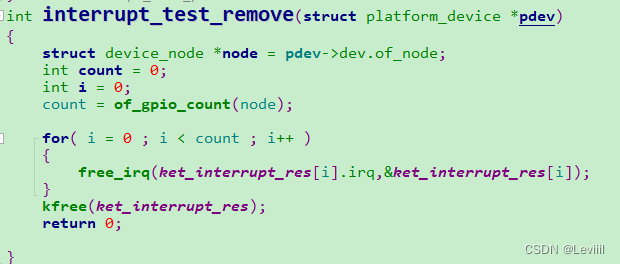前两篇文章主要是理论上的知识,此文章主要内容为代码上的编写以及思路等
目录
设备树中的操作
中断控制器
我们首先要在设备树当中创建对应的中断节点,首先我们需要了解一下中断控制器这个概念,在硬件的概念上,中断控制器其实只有GIC,但是在软件上,我们也可以把GPIO看为一个中断控制器,所以,从软件层面上看,中断控制器包括GIC、GPIO1、GPIO2等,一个GPIO上可能连接多个外部设备,它们共用一个中断号,此GPIO控制这些中断号。

GPIO1 连接到 GIC,GPIO2 连接到 GIC,所以 GPIO1 的父亲是 GIC,GPIO2 的父亲是 GIC。
假设GPIO1总共控制32个中断外部设备,假设其中16个共用一个中断号,另外16个共用另一个中断号,那么GPIO1总共会使用到GIC的两个中断号,会涉及 GIC 里的 2 个 hwirq。这些都会在设备树当中体现出来。
在设备树当中,如果存在属性:interrupt-controller,则表示该节点为中断控制器,除此之外,还需要另外一个属性,#interrupt-cells,表示使用这个中断控制器需要多少个cell
如果中断控制器存在级联关系,那么子级的中断控制器需要指定自己的父级中断控制器为哪个,比如上级的GPIO中断控制器需要指定自己的 interrupt-parent 为GIC。
设备树中使用中断
一个外设,使用哪一个中断控制器,使用中断控制器的哪个引脚,中断的触发方式在设备树中是如何体现出来的。
interrupt-parent=< &xxxx > 使用的父级中断控制器为哪个
interrupts 使用的父级中断控制器的引脚,具体几个cell表示由父级决定

为了方便,通常interrupt-parent和interrupts两个属性可以合起来,使用 interrupts-extended来进行表示。
interrupts-extended = <&intc1 5 1>, <&intc2 1 0>;
&intc1和&intc2:这些是中断控制器的引用,它们是设备树中定义的节点,负责管理中断请求。
5和1:这些是中断号,它们是中断控制器分配给特定设备的中断请求号。
1和0:这些是中断的触发类型。
编程思路
设备树相关
在这里,我们需要使用两个按键来触发中断,我们首先查阅引脚图,来判断使用的引脚以及触发的方式。

我们可以依照这些信息编写出如下设备树信息:
节点的名称为:gpio_key_interrupt
compatible的值为"100ask_interrupt_test",用来适配驱动程序
gpios属性指定了引脚GPIO5 1和 GPIO4 14为中断源,当它们为低电平的时候看为中断触发
gpio_key_interrupt {
compatible = "100ask_interrupt_test";
gpios = <&gpio5 1 GPIO_ACTIVE_LOW
&gpio4 14 GPIO_ACTIVE_LOW >;
};但是这些还是不够完整的,我们需要使用pinctrl来指定这两个引脚的为GPIO功能,表明自身是哪一个 GPIO 模块里的哪一个引脚。
使用引脚配置工具按照如下方式指定,然后把对应生成代码拷贝到dts文件当中


GPIO5 1引脚的配置如上 GPIO4 14所示,但是需要注意的是,存在的节点GPIO4为iomuxc,但是GPIO5为iomuxc_snvs。

gpio_key_interrupt {
compatible = "100ask_interrupt_test";
gpios = <&gpio5 1 GPIO_ACTIVE_LOW
&gpio4 14 GPIO_ACTIVE_LOW >;
pinctrl-names = "default";
pinctrl-0 = <&KEY1_interrupt
&KEY2_interrupt>;
};设备树文件就完成了,把它编译后,放置于开发板的 /boot/ 目录下。
驱动程序相关
驱动程序的主要思路如下:
一、编写驱动的出口函数和入口函数
二、定义 platform_driver 结构体,重点填充 probe 以及 remove
三、在probe函数中获取设备树中节点的各种GPIO信息,并为它们创建中断号,remove主要用于清除这些信息
四、中断处理函数的编写
五、驱动卸载的一些操作函数

如下结构体为 platform_driver结构体的填充,主要就是完成probe函数,在该结构体的driver成员的of_match_table的类型为 of_device_id 结构体,我们需要再定义一个此结构体,然后填充此结构体的compatible属性,用来匹配设备树。

probe函数主要实现在设备树中获取对应的引脚信息,然后通过对应的引脚信息来创建中断,创建中断的时候,需要创建中断处理函数,在这里我们的中断处理函数负责读取当前按键的值


remove函数主要用来通过对应的中断号来清除对应的中断,在这里我们还需要释放kzalloc申请的内核态的堆区空间

如果内核没有打印日志信息,使用如下命令:
echo "7 4 1 7" > /proc/sys/kernel/printk
Makefile如下
KERN_DIR = /home/book/100ask_imx6ull-sdk/Linux-4.9.88
all:
make -C $(KERN_DIR) M=`pwd` modules
clean:
make -C $(KERN_DIR) M=`pwd` modules clean
rm -rf modules.order
obj-m += interrupt_test.o
#include <linux/module.h>
#include <linux/fs.h>
#include <linux/errno.h>
#include <linux/miscdevice.h>
#include <linux/kernel.h>
#include <linux/major.h>
#include <linux/mutex.h>
#include <linux/proc_fs.h>
#include <linux/seq_file.h>
#include <linux/stat.h>
#include <linux/init.h>
#include <linux/device.h>
#include <linux/tty.h>
#include <linux/kmod.h>
#include <linux/gfp.h>
#include <linux/gpio/consumer.h>
#include <linux/platform_device.h>
#include <linux/of_gpio.h>
#include <linux/of_irq.h>
#include <linux/interrupt.h>
#include <linux/irq.h>
#include <linux/slab.h>
/* 中断结构体,存储按键中断的GPIO等信息 */
struct key_gpio{
int gpio;
int irq;
enum of_gpio_flags flag;
};
static struct key_gpio* ket_interrupt_res;
/* 中断函数 */
static irqreturn_t irq_handler(int irq , void *dev_id)
{
struct key_gpio* p_key_gpio = (struct key_gpio*)dev_id;
int val;
val = gpio_get_value(p_key_gpio->gpio);
printk("key %d %d\n", p_key_gpio->irq , val);
return IRQ_HANDLED;
}
int interrupt_test_probe(struct platform_device *pdev)
{
int count = 0;
int i = 0;
struct device_node *node = pdev->dev.of_node;
enum of_gpio_flags flag;
int err;
/* 获取GPIO中断个数 */
count = of_gpio_count(node);
ket_interrupt_res = kzalloc(count * sizeof(struct key_gpio), GFP_KERNEL);
if( !count )
{
printk("%s %s line %d, there isn't any gpio available\n", __FILE__, __FUNCTION__, __LINE__);
return -1;
}
for( i = 0 ; i < count ; i++ )
{
ket_interrupt_res[i].gpio = of_get_gpio_flags(node , i , &flag);
if( ket_interrupt_res[i].gpio < 0 )
{
printk("%s %s line %d, of_get_gpio_flags fail \n", __FILE__, __FUNCTION__, __LINE__);
}
ket_interrupt_res[i].irq = gpio_to_irq(ket_interrupt_res[i].gpio);
ket_interrupt_res[i].flag = flag & OF_GPIO_ACTIVE_LOW;
err = request_irq(ket_interrupt_res[i].irq, irq_handler, IRQF_TRIGGER_RISING | IRQF_TRIGGER_FALLING, \
"ket_interrupt", &ket_interrupt_res[i]);
}
return 0;
}
int interrupt_test_remove(struct platform_device *pdev)
{
struct device_node *node = pdev->dev.of_node;
int count = 0;
int i = 0;
count = of_gpio_count(node);
for( i = 0 ; i < count ; i++ )
{
free_irq(ket_interrupt_res[i].irq,&ket_interrupt_res[i]);
}
kfree(ket_interrupt_res);
return 0;
}
static const struct of_device_id ask100_interrupt[] = {
{ .compatible = "100ask_interrupt_test" },
{ },
};
static struct platform_driver interrupt_test_driver = {
.probe = interrupt_test_probe,
.remove = interrupt_test_remove,
.driver = {
.name = "100ask_interrupt",
.of_match_table = ask100_interrupt,
},
};
static int __init interrupt_test_init(void)
{
int err;
printk("%s %s line %d\n", __FILE__, __FUNCTION__, __LINE__);
printk(" interrupt_test_driver register \n");
err = platform_driver_register(&interrupt_test_driver);
return err;
}
static void __exit interrupt_test_exit(void)
{
printk("%s %s line %d\n", __FILE__, __FUNCTION__, __LINE__);
printk(" interrupt_test_driver unregister \n");
platform_driver_unregister(&interrupt_test_driver);
}
module_init(interrupt_test_init);
module_exit(interrupt_test_exit);
MODULE_LICENSE("GPL");